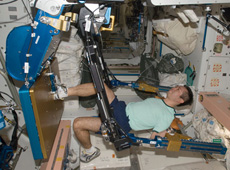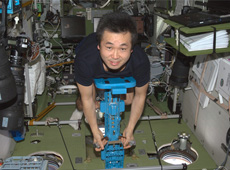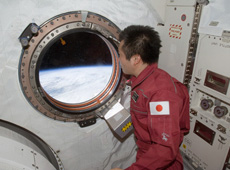
Astronaut Wakata exercising using the Advanced Resistive Exercise Device (ARED) (Courtesy of NASA)
Q. How will space-based medical research benefit Earth's medical technology?
As I explained earlier, space medicine is the ultimate preventive medicine. It is good if your illness is cured, but it's better if you can avoid getting ill in the first place. For example, women's bones increasingly weaken after menopause, but astronauts' bones weaken almost 10 times faster than those of elderly osteoporosis patients. Astronaut Wakata spent about four and a half months in space. Despite his two-hour daily exercise routine, the effect of the other 22 hours of the day was the same as being bedridden on Earth. On Earth, even when we are not exercising, we are resisting gravity - when we raise our hands, or lift a pen, or do anything at all. We are constantly experiencing gravity. We still don't know whether 1G is the ideal gravity for human beings, but we need a certain degree of it to live a healthy life.
Bodily changes such as bone density loss happen much more quickly in the extreme environment of space, but they occur on Earth as well. If we can find a way to prevent such degeneration, I think it will be very useful in our daily life on Earth too.
Finally, the advanced telemedicine system that we are working on for use in space can be very useful on Earth as well. We expect that it will help alleviate the doctor shortage problem, and improve medical technology with the use of small, sophisticated pieces of equipment developed for space use. I believe that other research results will also bring wide ranging benefits to people on Earth.
As I explained earlier, space medicine is the ultimate preventive medicine. It is good if your illness is cured, but it's better if you can avoid getting ill in the first place. For example, women's bones increasingly weaken after menopause, but astronauts' bones weaken almost 10 times faster than those of elderly osteoporosis patients. Astronaut Wakata spent about four and a half months in space. Despite his two-hour daily exercise routine, the effect of the other 22 hours of the day was the same as being bedridden on Earth. On Earth, even when we are not exercising, we are resisting gravity - when we raise our hands, or lift a pen, or do anything at all. We are constantly experiencing gravity. We still don't know whether 1G is the ideal gravity for human beings, but we need a certain degree of it to live a healthy life.
Bodily changes such as bone density loss happen much more quickly in the extreme environment of space, but they occur on Earth as well. If we can find a way to prevent such degeneration, I think it will be very useful in our daily life on Earth too.
Finally, the advanced telemedicine system that we are working on for use in space can be very useful on Earth as well. We expect that it will help alleviate the doctor shortage problem, and improve medical technology with the use of small, sophisticated pieces of equipment developed for space use. I believe that other research results will also bring wide ranging benefits to people on Earth.
Q. Astronaut Soichi Noguchi is scheduled to stay in space for about six months. What is the agenda for the next long-duration stay in space?


Personal Dosimeter
Although Astronaut Wakata is the first Japanese to have completed a long-duration stay in space, it is not unusual for U.S. astronauts to spend six to nine straight months in space, and a Russian astronaut has logged more than a year. So in this area, the United States and Russia are ahead. But NASA's three areas of research are the same as Japan's: space radiation, psychology, and loss of bone and muscle mass.
Studying space radiation, we investigate its effects on bodies, methods to measure exposure, and ways to prevent it. The maximum duration of a safe stay in space depends on the dose of space radiation astronauts are exposed to, so we must be able to accurately measure and analyze the exposure, and protect them from it.
In the area of psychology, we study leadership and teamwork, as well as methods of stress relief to build a good strong team. Astronauts' mental care is very important because, for example, having a team of two remarkable astronauts does not necessarily always make for a good working relationship, as they may end up getting in each other's way.
As for physiological measures, bone and muscle health is a critically important issue. The human body adapts to a new environment so well that it more or less settles down after a while. For example, in a zero-gravity environment, you may experience space motion sickness or feel some heart trouble at first. But in time, your body starts to adapt to the space environment. How long it takes depends on the organ, but it usually takes a day or two for space sickness to settle down, and about three days for the heart. And finally, in about a week, most of your body will get accustomed to the space environment. However, bones and muscles are exceptions - they do not adapt to the environment. The longer you stay in space, the more your bones lose calcium and your muscles weaken. It is very important that we work to break this paradigm. The main questions are: Why do bones and muscles weaken in space? What is the most effective exercise and nutrition program for prevention? Can hormones or medication solve the problem? This research is also applicable to Earth medicine, to find an answer to the question of why a bedridden state weakens bones, and to find a way to prevent osteoporosis.
Studying space radiation, we investigate its effects on bodies, methods to measure exposure, and ways to prevent it. The maximum duration of a safe stay in space depends on the dose of space radiation astronauts are exposed to, so we must be able to accurately measure and analyze the exposure, and protect them from it.
In the area of psychology, we study leadership and teamwork, as well as methods of stress relief to build a good strong team. Astronauts' mental care is very important because, for example, having a team of two remarkable astronauts does not necessarily always make for a good working relationship, as they may end up getting in each other's way.
As for physiological measures, bone and muscle health is a critically important issue. The human body adapts to a new environment so well that it more or less settles down after a while. For example, in a zero-gravity environment, you may experience space motion sickness or feel some heart trouble at first. But in time, your body starts to adapt to the space environment. How long it takes depends on the organ, but it usually takes a day or two for space sickness to settle down, and about three days for the heart. And finally, in about a week, most of your body will get accustomed to the space environment. However, bones and muscles are exceptions - they do not adapt to the environment. The longer you stay in space, the more your bones lose calcium and your muscles weaken. It is very important that we work to break this paradigm. The main questions are: Why do bones and muscles weaken in space? What is the most effective exercise and nutrition program for prevention? Can hormones or medication solve the problem? This research is also applicable to Earth medicine, to find an answer to the question of why a bedridden state weakens bones, and to find a way to prevent osteoporosis.
Q. What was the health management program for Astronaut Wakata's stay in space?



Astronaut Wakata weighing himself (Courtesy of NASA)

Electrocardiograph (Courtesy of Fukuda Denshi Co., Ltd.)
His health management was looked after by JAXA's Astronaut Medical Operations Group. He was instructed to closely monitor his nutrition, to keep regular hours, and to do two hours of daily exercise to prevent bone and muscle loss. For his mental care, he had a regular interview every two weeks with an expert, and to relieve stress, he communicated with his family via Internet or by phone. In terms of radiation, when it increased due to stronger solar activity, he was instructed to temporarily move to a location on the ISS with low exposure.
Q. What kind of medical experiments did he perform?
Japan has three medical research programs. One is a joint research program with NASA to test whether a class of drugs called Bisphosphonates are effective in preventing bone density loss. Some of the crew were on the medication and some were not, and their bone density is being studied upon their return to Earth. Of course, in medical research, we need a large number of data samples, so it's not just about Astronaut Wakata's results. If the drug proves to be effective, it will be a significant development, allowing bones to be protected without exercise.
The second research effort is to test a dosimeter called PADLES developed by JAXA. It is a wearable unit to determine radiation dosage in space.
The third experiment is testing a small electrocardiograph, called a Holter monitor, which is part of the space station's telemedicine system. This device took electrocardiogram readings around-the-clock, and the data was continuously sent to Earth. We used the Holter monitor to study biorhythms - shifts in the human biological clock. Also, we are trying to add a high-definition camera to the telemedicine toolbox. On Earth, doctors use their eyes (i.e. visual inspection) to examine patients. We are investigating whether a high-definition camera can be used for remote visual inspection in space.
Q. What kind of medical experiments did he perform?
Japan has three medical research programs. One is a joint research program with NASA to test whether a class of drugs called Bisphosphonates are effective in preventing bone density loss. Some of the crew were on the medication and some were not, and their bone density is being studied upon their return to Earth. Of course, in medical research, we need a large number of data samples, so it's not just about Astronaut Wakata's results. If the drug proves to be effective, it will be a significant development, allowing bones to be protected without exercise.
The second research effort is to test a dosimeter called PADLES developed by JAXA. It is a wearable unit to determine radiation dosage in space.
The third experiment is testing a small electrocardiograph, called a Holter monitor, which is part of the space station's telemedicine system. This device took electrocardiogram readings around-the-clock, and the data was continuously sent to Earth. We used the Holter monitor to study biorhythms - shifts in the human biological clock. Also, we are trying to add a high-definition camera to the telemedicine toolbox. On Earth, doctors use their eyes (i.e. visual inspection) to examine patients. We are investigating whether a high-definition camera can be used for remote visual inspection in space.
Q. What are the findings so far in the telemedicine experiments?

We did three experiments to validate the telemedicine system. For the biorhythm experiment, the U.S. and Russian astronauts joined Astronaut Wakata, and the data is already under analysis. But the volume of data is small, so it will take more time and participation from more astronauts until we can obtain results. As for the telemedicine system as a whole, we are satisfied with the results, for we were able to validate data acquisition and transmission to Earth. Data analysis is now in progress, and we are also looking at the possibility of developing a simple data analysis instrument that can be used in orbit. As far as the medical research targeting humans goes, we cannot release Astronaut Wakata's data for privacy reasons. We cannot release research data to the public until we collect five or six data samples, so they cannot be identified. Basically, we need more data to obtain valid results.

Astronaut Wakata viewing Earth. Telemedicine experiment data was successfully transmitted to Earth (Courtesy of NASA)